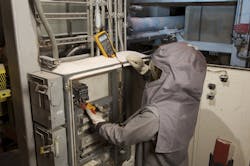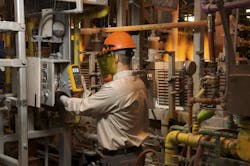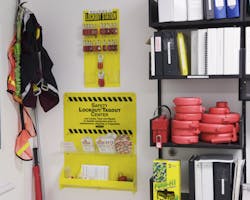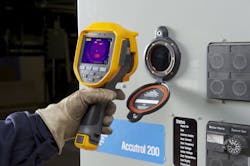If electricians who retired 40 or 50 years ago came back to work in one of today’s manufacturing plants or commercial buildings, they would likely be amazed by all the new technology. What would seem very familiar, however, are the hazards of working on electrical equipment. The basic laws of electricity haven’t changed since electricity was discovered. Electricians still must worry about arc flash, power surges, unexpected voltage on supposedly de-energized circuits, shorts and spikes, and troubleshooting around moving equipment and in hard-to-reach locations.
Fortunately, as technology has evolved so have the tools available to troubleshoot and maintain electrical equipment. Many safety improvements have been driven by U.S. Occupational Safety and Health Administration (OSHA) standards and the National Fire Protection Association (NFPA) 70E, Standard for Electrical Safety in the Workplace. Others have come from tool manufacturers who are constantly working to increase the safety and utility of their products.
Digital multimeters have come a long way in increasing safety by offering a higher level of protection against transient voltage spikes. The CAT rating combined with the
voltage rating on the multimeter indicates the level of transient protection. The higher the CAT rating, the higher the transient protection.
Default to de-energized systems
Although safety regulations and tool improvements have helped reduce electrical-related fatalities over the last decade, there is one practice that still results in a significant number of injuries every year — and that’s the practice of electricians unnecessarily risking their lives to conduct energized work. NFPA 70E clearly specifies that working on energized systems should only occur in certain situations where:
- It would be infeasible to de-energize the system due to increased hazard.
- The system runs on less than 50V .
- The equipment must be running to be tested.
So, one of the biggest changes in safety over the last few decades is system design that makes it easier to perform maintenance de-energized, and increased emphasis on the need to work de-energized. However, if that is not possible, there are several additional developments that can increase safety and productivity.
Heavy-duty digital multimeters increase transient resistance
The International Electrotechnical Commission (IEC) defines the safety standards for test equipment. Digital multimeters (DMMs) have come a long way in increasing safety by offering a higher level of protection against transient voltage spikes. One way to determine the level of transient protection is to look at the CAT rating. That rating — from CAT I to CAT IV — combined with the voltage rating of the multimeter indicates the level of transient protection.
The CAT rating is used to match the meter to the application. For example, CAT I is for electronics (e.g., copy machines); CAT II is for receptacle outlet circuits and plug-in loads; CAT III includes permanently installed loads and 3-phase circuits; and CAT IV includes outdoor utility-level runs between the meter and panel.
The higher the CAT rating, the higher the maximum voltage and maximum impulse protection. Within the same category, a meter with a higher voltage rating would offer a greater transient withstand rating than a lower voltage model. This means a CAT III 1,000V meter would offer better protection than a CAT III 600V meter. Other components, such as heavy-duty fuses, double-insulated test leads with shrouded input connectors, finger guards, and features like continuity testing, also increase the safety of DMMs.
One of the biggest changes in safety over the last few decades is system design that makes it easier to perform maintenance de-energized, and increased
emphasis on the need to work de-energized.
Non-contact tools measure voltage without test leads
Electricians frequently sort through crowded electrical boxes to find a safe metallic contact for measurement purposes. But with today’s advanced equipment, there’s no need for test leads or digging around in a box to find a metal contact point. An electrician can now use a non-contact electrical tester with an open fork design to take a voltage measurement. This is an example of how new measurement equipment designs can make it safer, easier, and faster to test for the presence of voltage virtually anywhere.
Personal protective equipment becomes more user friendly
In electrical applications, personal protective equipment (PPE) refers to a variety of items including clothing, helmets, eye and ear protection, and face shields designed to protect workers from arc flash or arc blast. While some form of PPE has always been used, it wasn’t until after The Occupational Safety and Health Act of 1970 was passed by the U.S. Congress that wearing PPE would eventually become mandatory. The subsequent creation of the Occupational Safety and Health Administration (OSHA) was a huge step forward in protecting workers from on the job injuries.
The increased focus on workplace safety led to the introduction of NFPA 70E in 1979. NFPA 70E sets the electrical safety practices standards (including PPE requirements) on how to protect workers from electric arc flash and arc blast. It has been updated several times over the years, and since 2012 it’s been on a three-year update cycle. The most current edition of the standard is dated 2018.
The initial problem was that workers found the original PPE extremely bulky, hot, and difficult to maneuver in, which meant that most electricians avoided wearing it. The early PPE equipment was also cost prohibitive. Fortunately, the science of arc-rated clothing and protective equipment has evolved since then — and so have the PPE requirements in NFPA 70E. Thus, arc-rated PPE has become more available and affordable, easier to maneuver in, and more comfortable to wear, which has led to increased use by electrical workers. This, in turn, has contributed to the decrease in electrical fatalities for qualified workers.
Infrared technology keeps workers at a safer distance
For equipment that can’t be de-energized, the next best thing is to keep workers as far away from energized components as possible. One example of this has been incorporating infrared (IR) technology into successful preventive maintenance programs. In the last decade, IR inspection tools — thermal imagers, IR thermometers, and IR windows — have decreased in cost and complexity, making them much more affordable and practical for electricians to add to their tool bags.
Electricians can use thermal imagers or visual IR thermometers to quickly measure surface temperatures of equipment in hard to reach or hazardous areas from a greater distance. They can quickly scan electrical panels to find hot spots and issues within the electrical system. Significant temperature differences can indicate loose connections, imbalanced or overloaded circuits, defective breakers or fuses, defective materials, and other conditions that can lead to equipment failures and severe electrical hazards for personnel. If the scan shows temperature anomalies, the electrician can don appropriate PPE and move in for a closer look.
Another way to enhance the safety of IR inspections is by installing certified IR windows in electrical equipment panels and enclosures. This improved design feature allows workers to leave covers in place while inspecting live equipment both visually and with a thermal imager. By not having to open the panel cover they eliminate one of the steps that can cause arc blast incidents and they also increase efficiency.
IR windows should be rated for the highest potential arc blast hazard based on equipment voltage. The windows should be grounded to the metal enclosure to avoid the release of static electricity. It’s also handy to have easy-to-open window covers that stay attached to the panel when removed from the window. It is even possible to install IR windows protected by a security key if they are installed in an unsecured area.
Enhance the safety of infrared inspections by installing certified IR windows in electrical equipment panels and enclosures. This improved design feature allows workers
to leave covers in place while inspecting live equipment both visually and with a thermal imager. This reduces the potential of exposure to an arc blast while increasing efficiency.
Wireless test tools extend the safety zone
The increased demand for power monitoring reflects the growing demand for improved electrical efficiency. Wireless monitoring technology is an example of improving tool design to make performing this work as safe and efficient as possible.
While IR technology has allowed electricians to work further away from arc flash hazards, today’s wireless test tools can move electricians even further away — even out of the building. For example, technicians can use a wireless power monitor to measure all three-phases simultaneously from several feet away. They make the voltage and current connections inside the electrical equipment, close the panel door, move several feet away, and re-energize the system.
They can check the results on a mobile device to confirm that the meter is hooked up correctly and gathering the necessary data. Technicians can read the results in another part of the building or thousands of miles away. Some meters even allow adjustments remotely from a tablet or smartphone.
Along the same lines, wireless sensors can be temporarily mounted to equipment to log AC and DC volts and amps, contact or IR temperature, and power quality. The results can be saved to a database and monitored in real time on a mobile device or PC. Because these sensors can collect data over days, weeks, months, or continuously, they make it easier and safer to catch intermittent problems. They also provide a comprehensive picture of equipment performance which helps identify:
- Three-phase power imbalances from harmonic distortion, overloads, or degradation or failure of one or more phases.
- Motor amperage spikes or overheating from bad bearings or insulation breakdown.
- Potential overloads or component failures in electrical panels.
- Power consumption .
Best of all, this information can be collected day or night and monitored or reviewed without having to send an electrician anywhere near the equipment.
These are just a few examples of the safety improvements in tools, procedures, and system design made over the last few decades to improve electrical safety and reliability. There are dozens of others and that list will continue to grow, because going home safe each day should always be the priority for every electrician.
Silvey is an application specialist with Fluke Corp., Everett, Wash. He can be reached at [email protected].
About the Author

Sean Silvey
Application Specialist
Sean Silvey is an application specialist for Fluke, which manufactures electrical test and measurement tools, including multimeters, clamp meters and insulation, earth ground and installation testers. Sean Silvey has been an application specialist at Fluke for the past seven years. Prior to that, he was a residential/commercial HVAC technician, most recently a field service manager. Sean’s focus is on application awareness and product education; and most recently, he has been building expert knowledge in the Clean Tech fields of solar and eMobility, helping Fluke drive innovation of tools that help technicians in these fields get their work done safely and efficiently.



